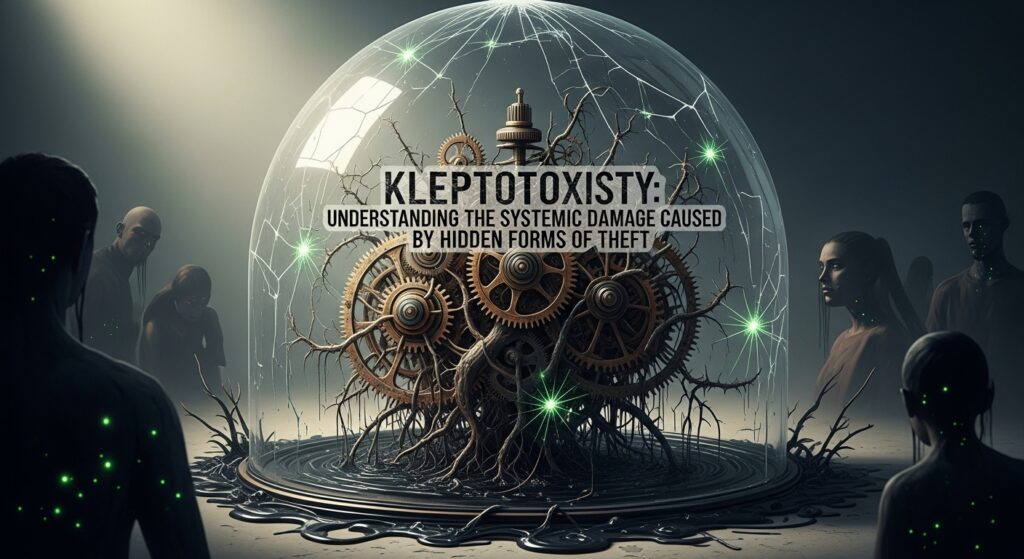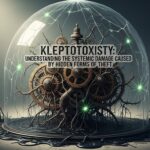Kleptotoxicity is an emerging conceptual term that helps explain the long-term harm caused by recurring, systemic, or institutionalized theft. While traditional definitions of theft focus on a single act, kleptotoxicity highlights the cumulative, slow-burning damage that occurs when individuals, groups, or institutions repeatedly take resources that do not belong to them. This harm is not only economic—it affects social structures, political systems, trust networks, creative innovation, and even the environment.
Although not yet a formal scientific category, the concept is increasingly used in discussions about corruption, governance, social decay, and the erosion of public goods. It captures the idea that theft behaves like a toxin: it may go unnoticed at first, but over time it can poison entire systems.
This article explores the meaning of kleptotoxicity, its different forms, the mechanisms through which it spreads, its consequences, and the strategies that societies can use to neutralize it.
What Is Kleptotoxicity?
The word “kleptotoxicity” blends two ideas:
-
Klepto — relating to stealing or the act of taking something unlawfully.
-
Toxicity — the quality of being harmful, corrosive, or damaging over time.
Taken together, kleptotoxicity refers to the destructive effects that result when theft becomes embedded in personal behavior, organizational culture, or public institutions.
Unlike simple theft, which is immediate and visible, kleptotoxicity emphasizes:
-
cumulative harm
-
structural consequences
-
erosion of trust
-
damage to long-term stability
-
ripple effects on multiple systems
It helps us understand why certain societies or institutions collapse, why innovation slows, and why people lose confidence in leadership.
Why the Concept Matters Today
In an era of rising inequality, environmental exploitation, and digital manipulation, kleptotoxicity provides a lens to analyze problems that cannot be explained by individual wrongdoing alone.
It helps describe:
-
how corruption becomes embedded
-
why communities lose faith in authority
-
how resources disappear from public use
-
why ecosystems degrade from unchecked extraction
-
how creative industries suffer from idea theft
The term highlights that theft is not just a legal violation; it is a toxin that weakens everything it touches.
Forms of Kleptotoxicity
Kleptotoxicity manifests across several domains. Each form has its own mechanisms, but all share the same underlying pattern: repeated theft causing long-term systemic damage.
1. Economic Kleptotoxicity
Economic kleptotoxicity refers to the harm caused when financial theft becomes normalized or widespread. This can occur at the individual level, but it is most toxic when committed by those with financial power or access to public funds.
Examples include:
-
embezzlement in corporations
-
misallocation of public budgets
-
fraudulent accounting practices
-
covert resource diversion
-
inflated contracts designed to extract public money
The results can be severe:
-
weakened economic growth
-
shortages of funds for healthcare, education, and infrastructure
-
reduced investor confidence
-
higher taxes on citizens to cover financial gaps
When economic kleptotoxicity takes root, the entire financial environment becomes unstable and unpredictable.
2. Political and Institutional Kleptotoxicity
Political kleptotoxicity occurs when theft is woven into the functioning of public institutions. This goes beyond occasional corruption—it becomes part of the system.
Symptoms include:
-
bribery as a requirement for basic services
-
favoritism in public contracts
-
leaders using office for personal gain
-
regulatory bodies failing to enforce laws
-
secrecy surrounding government decisions
Institutional kleptotoxicity has profound consequences:
-
declining public trust
-
weakened democratic processes
-
ineffective governance
-
reduced quality of public services
-
difficulty implementing reforms
Over time, citizens may disengage from civic participation because they feel the system no longer represents them.
3. Environmental Kleptotoxicity
Environmental kleptotoxicity describes the long-term harm caused by the theft or misuse of natural resources.
Common forms include:
-
illegal logging
-
unregulated mining
-
unauthorized extraction of water
-
destruction of protected areas
-
exploitation of wildlife populations
The damage is often irreversible. It includes:
-
soil degradation
-
biodiversity loss
-
water scarcity
-
increased natural disasters
-
climate instability
Environmental kleptotoxicity is especially dangerous because the consequences affect future generations who had no part in the theft.
4. Social and Psychological Kleptotoxicity
Theft also produces intangible but powerful social toxins.
This includes:
-
loss of trust within communities
-
normalization of unethical behavior
-
emotional trauma for victims
-
increased fear and insecurity
-
resentment that divides groups
When kleptotoxicity takes hold socially, people may begin to believe that honesty no longer matters or that everyone acts in self-interest. This erodes the social fabric that keeps communities stable and cooperative.
5. Intellectual and Creative Kleptotoxicity
Not all theft is material. Ideas, art, and research can also be stolen, leading to intellectual kleptotoxicity.
Examples include:
-
plagiarism
-
unauthorized copying or reproduction
-
theft of cultural practices
-
misappropriation of traditional knowledge
-
taking credit for another’s work
The consequences include:
-
demotivated creators
-
slowed innovation
-
unrecognized talent
-
erosion of cultural heritage
When creative theft becomes common, entire industries suffer, and genuine creators face barriers to success.
6. Digital Kleptotoxicity
In a digital world, theft can occur on new fronts.
Digital kleptotoxicity refers to:
-
data theft
-
unauthorized collection of personal information
-
identity fraud
-
stealing digital assets
-
manipulating online systems for profit
This form of kleptotoxicity is growing rapidly and often goes undetected until significant damage has occurred.
How Kleptotoxicity Spreads
Kleptotoxicity spreads in patterns similar to toxins or infectious agents. Once theft becomes expected or tolerated, the behavior multiplies.
Here are key mechanisms that enable its expansion:
1. Normalization of Corruption
When people see repeated theft go unpunished, they begin to view it as acceptable or even necessary.
2. Weak Oversight
Lack of transparency, weak auditing systems, or inconsistent law enforcement make theft easier.
3. Power Imbalances
Those with control over resources face fewer obstacles to taking more than they are entitled to.
4. Economic Stress
In times of uncertainty, individuals and institutions may rationalize unethical behavior as survival.
5. Cultural Factors
In some contexts, loyalty or group identity is valued over integrity, allowing corruption to spread.
6. Technological Complexity
Digital systems create opportunities for sophisticated theft that is hard to trace.
Consequences of Kleptotoxicity
The effects of kleptotoxicity are far-reaching and often long lasting.
1. Economic Collapse
When theft drains public or corporate resources, essential functions become underfunded, leading to instability.
2. Social Fragmentation
Communities become divided, and interpersonal trust declines.
3. Institutional Decay
Public agencies or companies become dysfunctional due to systemic corruption.
4. Loss of Innovation
Creative industries weaken when ideas are stolen rather than developed.
5. Environmental Damage
Natural resources degrade, causing ecological crises.
6. Generational Harm
Future societies inherit depleted systems, weakened institutions, and fewer opportunities.
How to Reduce or Prevent Kleptotoxicity
Although kleptotoxicity can be deeply embedded, it is not irreversible. Several strategies can help neutralize or counteract its effects.
1. Strengthening Transparency
Clear reporting systems, open financial data, and visible decision-making increase accountability.
2. Reinforcing Legal Frameworks
Consistent enforcement of laws reduces opportunities for systemic theft.
3. Supporting Ethical Leadership
Role models who value integrity can shift cultural norms.
4. Encouraging Civic Participation
Engaged citizens can hold institutions accountable.
5. Promoting Education on Ethics
Teaching responsibility and fairness at early ages reduces tolerance for theft.
6. Protecting Natural Resources
Environmental policies and community-based stewardship help safeguard ecosystems.
7. Innovating with Technology
Digital tools such as secure databases and tracking systems can reduce theft opportunities.
The Future of the Concept
Kleptotoxicity is gaining traction as societies look for ways to articulate the hidden harm caused by systemic misconduct. As global challenges evolve—especially those tied to climate change, digital security, and economic inequality—the term provides a useful framework for diagnosing the deeper causes of dysfunction.
It is likely that kleptotoxicity will continue to appear in social research, public policy debates, and discussions about sustainable development. Its value lies in making the invisible visible by showing that theft is more than a crime—it is a destructive force that can destabilize entire systems if left unchecked.
Conclusion
Kleptotoxicity helps explain why societies, institutions, and ecosystems sometimes fail even when individual acts of theft appear minor. By understanding it as a cumulative toxin, we gain insight into the long-term patterns of damage that occur when unethical extraction becomes normalized. Recognizing and confronting kleptotoxicity is essential for building transparent, sustainable, and resilient systems.






